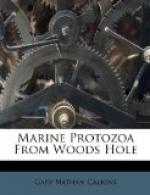Exuviaella lima Ehr. Fig. 18.
Synonyms Pyxidicula Ehr.; Cryptomonas
Ehr.; Prorocentrum lima
Kent; Amphidinium Pouchet.
The shell is ovate, rounded and swollen posteriorly. The anterior border of both shells is slightly indented. The shell is quite thick. The animal moves through the water very slowly. Dark brown in color. Length 48 mu; width 44 mu.
[Illustration: Fig. 18.—Exuviaella lima.]
Exuviaella marina Cienkowsky. Fig. 19.
A smaller form than the preceding, more elliptical in outline, with a thinner shell and with large granules throughout the endoplasm. The nucleus is spherical and subcentral in position and possesses a distinct central granule. This may be a small variety of E. lima.
[Illustration: Fig. 19.—Exuviaella marina.]
Genus GYMNODINIUM Stein ’78.
(Bergh ’81; Kent ’81; Pouchet ’83, ’85; Entz ’84; Schuett ’95.)
The general structure of these forms is similar to that of Glenodinium; the most striking and positive difference is the absence of a shell. The animals are, as a rule, spherical, yet they may be pointed at the two ends or at one of them. They are also frequently flattened dorso-ventrally. The transverse furrow may be either circular and straight around the body or may describe a spiral course, passing even twice around the body. The flagella arise near cross-furrow or, in some cases, in longitudinal furrow. Chromatophores may or may not be present and food-taking is holozoic, in many cases at least. In some cases ectoplasm and endoplasm can be distinguished. Fresh and salt water.
Gymnodinium gracile Bergh ’82, var. sphaerica, n. Fig. 20.
The body is divided by the transverse furrow into a shorter anterior and a longer posterior part. The longitudinal furrow is broader at the posterior extremity than at the cross-furrow. The structural feature upon which this new variety is made is the unvarying plumpness of the body, making it almost spherical, except for a slight flattening dorso-ventrally. The nucleus is large and ellipsoidal, with characteristic longitudinal markings of chromatin. The endoplasm is evenly granular, with a number of large ingested food bodies. The color is brown, not rose-red as in Bergh’s species, nor is the Woods Hole form as large as the latter. Length of body 68 mu; width 55 mu. Common.
[Illustration: Fig. 20.—Gymnodinium gracile, var. sphaerica.]
Genus GLENODINIUM (Ehr.), Stein ’83.
(Bergh ’82; Buetschli ’86; Pouchet ’85; Daday ’86.)
Small globular forms with two distinct furrows, one transverse around the body, the other longitudinal upon the face only. The shell is soft and structureless with a distinct aperture near the meeting point of the two furrows. The endoplasm usually, but not always, contains a bright red eye-spot.




